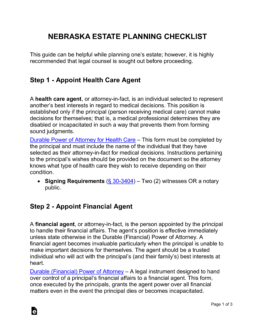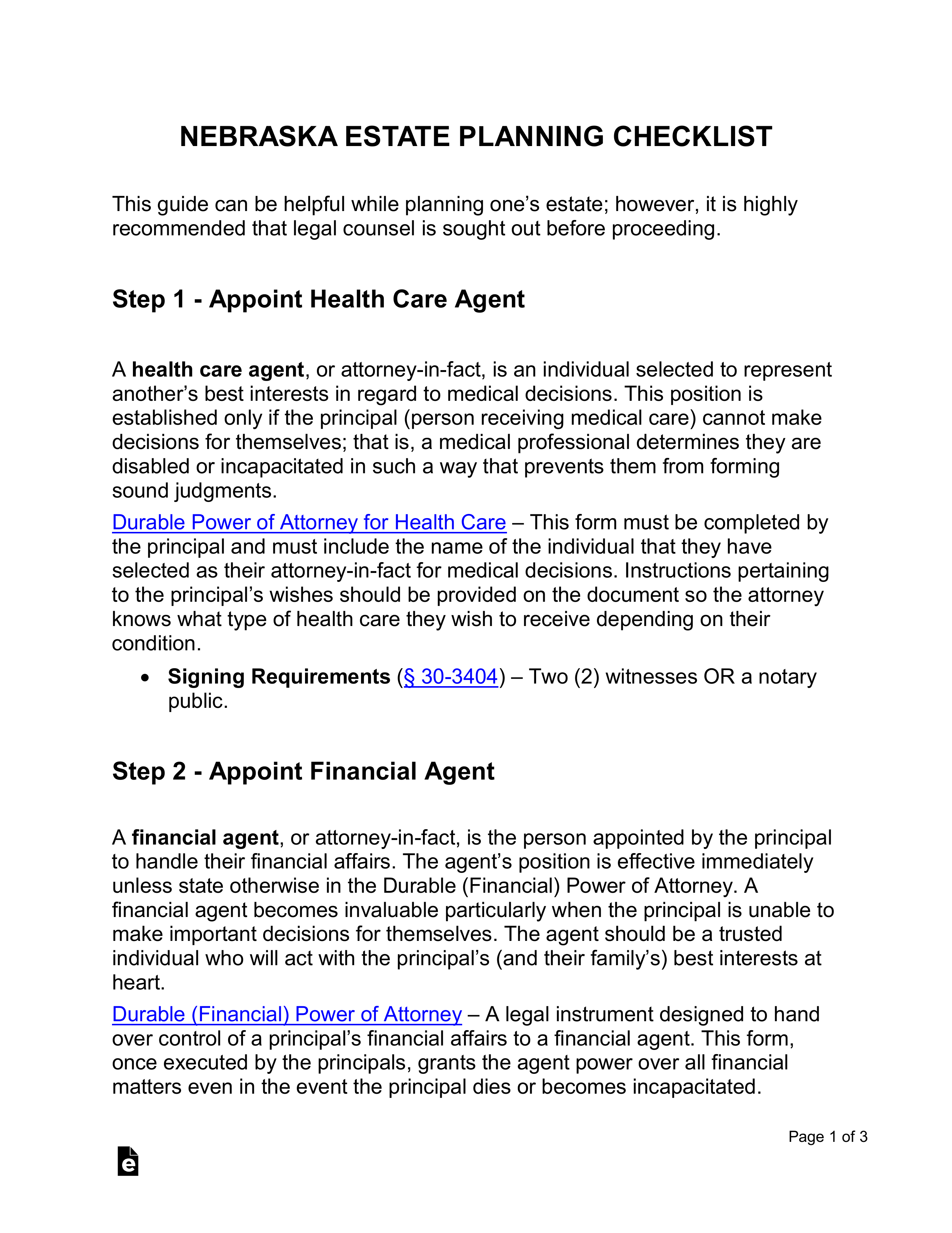Updated March 05, 2024
A Nebraska estate planning checklist is an organizational form for anyone working on their estate plan. An estate plan is a procedure involving a collection of legal instruments and forms that provide instructions to a person’s agents, representatives, family members, and other involved parties regarding that individual’s personal affairs. Death is unavoidable, and becoming disabled is unpredictable, but being prepared for these unfortunate occurrences is something that can and should be done before it’s too late. Documents such as a Durable Power of Attorney (Financial and Medical), a Last Will and Testament, and a Revocable Living Trust are integral parts of an estate plan and will be explained in more detail below.
How to Create an Estate Plan in Nebraska (6 steps)
- Appoint Health Care Agent
- Appoint Financial Agent
- Create List of Assets
- Choose Beneficiaries
- Create a Last Will and Testament or Living Trust
- Attend Hearing
This guide can be helpful while planning one’s estate; however, it is highly recommended that legal counsel is sought out before proceeding.
1. Appoint Health Care Agent
A health care agent, or attorney-in-fact, is an individual selected to represent another’s best interests in regard to medical decisions. This position is established only if the principal (person receiving medical care) cannot make decisions for themselves; that is, a medical professional determines they are disabled or incapacitated in such a way that prevents them from forming sound judgments.
Durable Power of Attorney for Health Care – This form must be completed by the principal and must include the name of the individual that they have selected as their attorney-in-fact for medical decisions. Instructions pertaining to the principal’s wishes should be provided on the document so the attorney knows what type of health care they wish to receive depending on their condition.
- Signing Requirements – Two (2) witnesses OR a notary public.[1]
2. Appoint Financial Agent
A financial agent, or attorney-in-fact, is the person appointed by a Principal to handle their financial affairs. The agent’s position is effective immediately unless stated otherwise in the Durable (Financial) Power of Attorney. A financial agent becomes invaluable particularly when the principal is unable to make important decisions for themselves. The agent should be a trusted individual who will act with the principal’s (and their family’s) best interests at heart.
Durable (Financial) Power of Attorney – A legal instrument designed to hand over control of a principal’s financial affairs to a financial agent. This form, once executed by the principal, grants the agent power over all financial matters even in the event the principal dies or becomes incapacitated.
- Signing Requirements – Must be acknowledged before a notary public or other authorized individual.[2]
Financial Powers Allowed:
- Real property[3]
- Tangible personal property[4]
- Stocks and bonds[5]
- Commodities and options[6]
- Banks and other financial institutions[7]
- Operation of entity or business[8]
- Insurance and annuities[9]
- Estates, trusts, and other beneficial interests[10]
- Claims and litigation[11]
- Personal and family maintenance[12]
- Benefits from governmental programs or civil or military service[13]
- Retirement plans[14]
- Taxes[15]
- Gifts[16]
3. Create List of Assets
4. Choose Beneficiaries
5. Create a Last Will and Testament or Living Trust
An essential stage in the estate planning process is drafting a Last Will and Testament or a Living Trust. Both documents are used to instruct representatives in how to distribute the principal’s assets after they die, but they each have their unique benefits and drawbacks.
Last Will and Testament – A document created by a person, “testator”, to convey their wishes regarding the distribution of their estate after they die. After the testator’s death, the executor is in charge of making sure each beneficiary receives their allotted portion of the estate. This estate planning document must go through probate court before the estate can be divided up. This can be a lengthy process, depending on the size of the estate and the amount of debt the testator had. A Self-Proving Affidavit can be completed to speed up the probate process.
- Signing Requirements – Two (2) witnesses.[17]
Living Trust (Revocable) – Unlike a Will, a Revocable Living Trust is an entity to which the grantor (principal) will transfer ownership of their property and assets. The grantor continues to benefit from their estate while they’re alive and, after they die, the beneficiaries inherit their designated portion. A Living Trust can also contain instructions concerning the management of their estate in the event of incapacitation or disability. Furthermore, a Revocable Living Trust will not have to go through probate court after the grantor’s death. Instead, the trustee (or successor trustee if the grantor has appointed themselves trustee) will be able to carry out the grantor’s wishes without court approval and while avoiding public record.
- Signing Requirements – Not mentioned in State law; a Self-Proving Affidavit (requires 2 witnesses) or a Notary Acknowledgement is highly recommended.
Summary – It is not uncommon for a person to not leave an asset or a portion of their estate out of a Living Trust; however, anything not included in a Trust should be written into a Last Will and Testament so there won’t be any complications after the principal’s death.
6. Store Documents
Nebraska Estate Planning Laws
- Durable (Medical) Power of Attorney – § 30-3401(-3432)
- Durable (Financial) Power of Attorney – § 30-4001(-4045)
- Last Will and Testament (Probate Code) – § 30-2201(-3001)
- Revocable Living Trust (Trust Code) – § 30-3501(-38,110)


